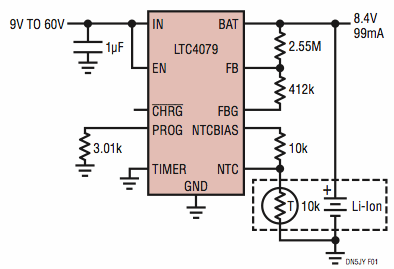LTC Design Note: Monolithic linear battery charger operates from inputs up to 60V
Some switch mode solutions can accept high input voltages and switching topologies offer current and efficiency advantages, but they also incur significant costs in complexity and solution footprint. In the end, a switch mode solution is usually overkill for the low currents necessary in keep-alive systems or backup battery chargers. Furthermore, few are suitable for automotive and industrial applications up to 60V.
The LTC4079 is a wide input range standalone charger that can be powered by any DC source from 2.7V up to 60V, enabling CC/CV charging directly from 12V and 24V DC system rails, or even 48V industrial supplies. Its marriage of simplicity and robustness allow it to easily satisfy the charging needs of keep-alive systems or backup battery solutions in these environments. Figure 1 is an example of a simple Li-Ion battery charger.
Figure 1 Wide Range Linear Standalone Charger for 2-Cell Li-Ion Backup Battery
Fortitude and Flexibility, Neatly Packaged
The LTC4079’s charge voltage is resistor-programmable, matching the flexibility of its wide input voltage range for practical purposes. The circuit is stable across the entire input voltage range with minimal input and output capacitance.
Using a single resistor on the PROG pin, charge current is programmable up to 250mA and can be monitored in proportion to the PROG voltage. Charge termination functionality is familiar: timer-based, programmed via TIMER pin capacitance, or, C/10 current detection by connecting the TIMER pin to ground. /CHRG status signals termination by either method. The timer capacitor is also used for bad-battery detection.
Temperature-qualified charging can be implemented via the NTC and NTCBIAS sensing network to round out the full charger circuit. The LTC4079’s thermally enhanced 3mm × 3mm DFN package includes an internal pass element, producing a compact and comprehensive solution. The complete circuit featured in Figure 2 shows its compact footprint.
Figure 2 Complete Demo Board Circuit Footprint
Innovative Regulation for Utility and Facility
The LTC4079 includes a number of enhancements over conventional chargers with several distinctive charge current regulation methods. First, for wide range, but current-limited or high impedance sources, the input voltage can be regulated to at least 160mV above the battery voltage (VIN(MIN) ≥ VBAT + 160mV). Charge current is reduced to prevent the input voltage from collapsing below this value, maximizing charge current. No external components are required to exploit this internal regulation scheme. Figure 3 shows an example of temperature-compensated float charging a 12V sealed lead acid battery stack from a solar panel, though any combination of input and battery voltages are possible.
The LTC4079's differential voltage regulation is particularly useful when very low power sources such as energy harvesters or small solar panels cannot continuously provide the minimum 10mA charge current. Instead of the somewhat arbitrary halt to charging in the face of an undervoltage lockout (UVLO), this feature allows charging to continue whenever possible—a more efficient use of available input power.
For a more specific input voltage regulation setpoint, the enable input pin, EN, can servo to a resistor divider. As the input voltage reaches this setpoint, the charge current is reduced to prevent loading the source any further. In this manner, the enable input can be used to set a minimum operating voltage for a given source.
The final current regulation method—thermal regulation—is important for a monolithic device in general, but should be mandatory for a linear regulator. This is especially useful in harsher ambient environments and for high VIN/VBAT ratios, where the charge voltage is much lower than the nominal input voltage. Charge current is reduced until the IC junction temperature is reduced below 118°C. See Figure 3 for an example circuit with input voltage regulation that prevents weak input sources from being overloaded.
Figure 3 Prevent Weak Sources from Being Overloaded with Input Voltage Regulation
For More Details: Monolithic linear battery charger operates from inputs up to 60V


